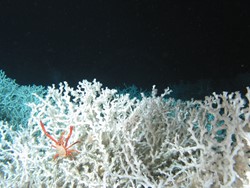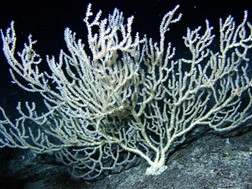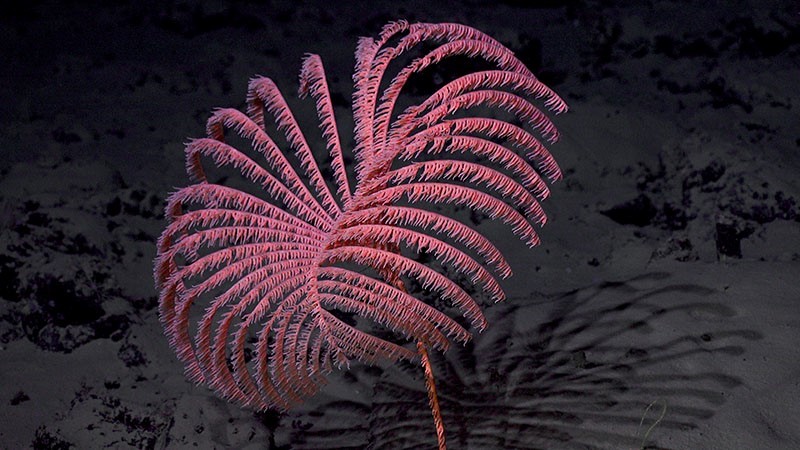Southeastern United States
 (Eumunida picta)From North Carolina south through the Florida Straits and into the Gulf of Mexico there are extensive deep water coral mounds, constructed primarily by the stony coral Lophelia pertusa. Off the Atlantic Coast of Florida there are also reefs of a similar species called Enallopsammia profunda, but these tend to be deeper than L. pertusa and are dominated by dead coral mounds rather than live coral. The depth reefs in this region ranges from an unusually shallow area off north Florida at approximately 200 m to > 800 m depth. Most corals need hard substrate for colonization and growth, and the carbonate platforms of the east coast and west Florida shelf provide abundant habitat for corals and other sessile fauna, both deep and shallow. The northern Gulf of Mexico however is primarily a soft sediment environment and hard substrate is limited to authigenic carbonate or exposed salt diapirs. The northern Gulf does not support the kind of extensive deep sea reef development found in the eastern Gulf or Atlantic, but there are sporadic locations of dense L. pertusa mounds. The northern Gulf also supports groves of large gorgonians and black corals, which provide habitat for numerous other invertebrates and fishes.
(Eumunida picta)From North Carolina south through the Florida Straits and into the Gulf of Mexico there are extensive deep water coral mounds, constructed primarily by the stony coral Lophelia pertusa. Off the Atlantic Coast of Florida there are also reefs of a similar species called Enallopsammia profunda, but these tend to be deeper than L. pertusa and are dominated by dead coral mounds rather than live coral. The depth reefs in this region ranges from an unusually shallow area off north Florida at approximately 200 m to > 800 m depth. Most corals need hard substrate for colonization and growth, and the carbonate platforms of the east coast and west Florida shelf provide abundant habitat for corals and other sessile fauna, both deep and shallow. The northern Gulf of Mexico however is primarily a soft sediment environment and hard substrate is limited to authigenic carbonate or exposed salt diapirs. The northern Gulf does not support the kind of extensive deep sea reef development found in the eastern Gulf or Atlantic, but there are sporadic locations of dense L. pertusa mounds. The northern Gulf also supports groves of large gorgonians and black corals, which provide habitat for numerous other invertebrates and fishes.
 There are many species of fishes that are closely associated with these deep coral reefs, some of which have potential fishery value but at the moment are not harvested commercially in this region. In an effort to protect the corals from future damage from fishing gear, the South Atlantic Fishery Management Council (SAFMC) established a series of deep coral Habitat Areas of Particular Concern (HAPC), and the Gulf of Mexico Fishery Management Council is currently in the process of identifying potential areas for protection. We have worked for many years in the southeastern US region, including the Gulf of Mexico, both before and after the Deepwater Horizon oil spill. We have studied reproductive cycles, growth rates and physiological tolerances of Lophelia pertusa. Although very fragile in many ways, this species is quite resilient to extreme environmental conditions, which may explain it’s almost global distribution.
There are many species of fishes that are closely associated with these deep coral reefs, some of which have potential fishery value but at the moment are not harvested commercially in this region. In an effort to protect the corals from future damage from fishing gear, the South Atlantic Fishery Management Council (SAFMC) established a series of deep coral Habitat Areas of Particular Concern (HAPC), and the Gulf of Mexico Fishery Management Council is currently in the process of identifying potential areas for protection. We have worked for many years in the southeastern US region, including the Gulf of Mexico, both before and after the Deepwater Horizon oil spill. We have studied reproductive cycles, growth rates and physiological tolerances of Lophelia pertusa. Although very fragile in many ways, this species is quite resilient to extreme environmental conditions, which may explain it’s almost global distribution.


